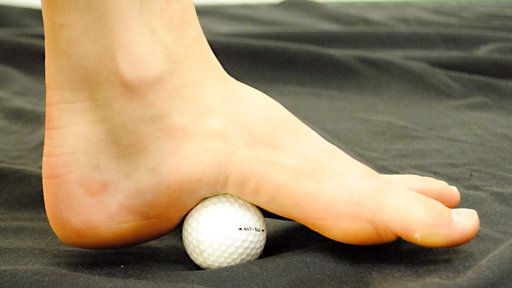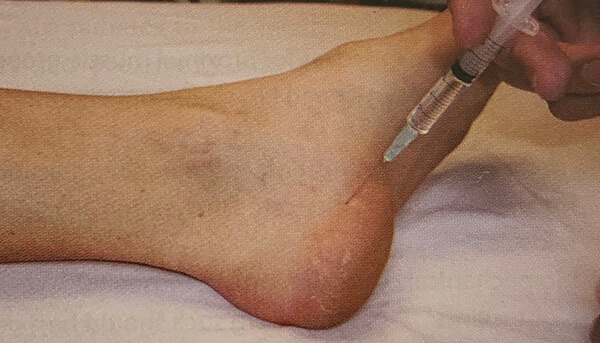Plantar fasciitis
What is plantar fasciitis?
Plantar fasciitis is the scientific or medical name given to heel pain which results from the inflammation of the soft tissue/ligamentous structure around the sole of the foot. This structure is often termed the Plantar Fascia.
The Plantar Fascia is a thick band of fibrous tissue that extends from the toes to the heel and provides support to the foot.
Plantar Fasciitis is the most common cause of heel pain in adults
It is a very common condition accounting for around 15% of foot injuries. It is often a chronic condition in nature meaning it has lasted over three to six months.
The mechanism is often a degenerative tear of the fascia where it inserts on the heel often leading to pain and swelling on the attachment to the heel bone.

When these fibres are looked at under the microscope the findings are often of those seen in chronic degenerated tendons in ‘wear and tear’ injuries
The pain is gradual in onset, however in a small amount of people there can be sudden damage to the fascia during physical activity causing intense heel pain on walking or running.
Occasionally the pain may also be present around the arch of the foot. Most commonly it occurs in one foot but it is possible to have it in both feet at the same time.
It can affect any adult and seems to affect those between the ages of 30-50 years. It can be more common younger adults who participate in athletic activities such as running. Females seem to be twice as likely to get Plantar Faciitis as males

Symptoms of Plantar Fasciitis?
Symptoms of Plantar Fasciitis are:
- Pain or tenderness is quite commonly located on the inside of the heel or arch in the majority of patients.
- The patient often describes the pain as similar to walking ‘on something sharp’ in the heel
- The patient will describe pain and an inability to put weight on the foot for several minutes upon waking in the morning and following periods of rest during the day.
Why does Plantar Fasciitis pain occur upon waking?
This is thought to be because during sleep the foot is relaxed in a position of flexion. Upon walking the foot is stretched and hence the plantar fascia is also stretched bringing in the pain. Putting weight on this painful fascia also results in pain
The pain is often relieved after walking for several minutes.
Sometimes however, prolonged activity or walking for more than half an hour can cause an increase in the irritation of the heel causing more pain.
The condition may become chronic to the point that pain is present throughout the day on weight-bearing and simple activities become unmanageable.
Causes of Plantar Fasciitis?
- Weight gain or high BMI (Body Mass Index)
- Tight plantar fascia (the broad sling of tissue under the sole)
- Certain activities/occupations which require long-standing especially cashiers/hospital workers/military/security. Basically any situation where you are stood on your feet for hours
- Excessive pronation of the foot or flat feet. (turning front part of foot inward)
- Activities such as running/athletics/dancing or a sudden increase in the distance or the intensity of these activities.
- Poor quality footwear or hard boots or walking/running on hard surfaces.
- Increasing age
- Medical conditions such as rheumatoid arthritis (this may cause weakening or rupture of the tissue)
- Very tight calf muscles.
A common fault can be an alteration in foot mechanics. Excessive or repetitive strain on the plantar fascia can lead to small tears and inflammation in this sheet of tissue.
Tight calf muscles can result in decrease ankle flexibility and micro-trauma in the fascia and inflammation when you lift you push your foot of the ground to take your next step.
Equally patients who pronate (turn foot inward) or supinate (turn foot outward) cause an excessive strain on the plantar fascia.
This increases tension and stress on the plantar fascia which may lead to micro tears or calcification in the fascia. This shows up as lines of stress or ‘bony spurs’ on an x-ray.
How do you Diagnose Plantar Fasciitis
A careful history and examination is taken by the clinician.
The patient will often mention heel pain and an inability to walk normally for several minutes after getting up first thing in the morning. A period of rest during the day may relieve the pain.
When the patient gets up to walk again the plantar fascia can become re-irritated and the pain starts again
Often the examiner will examine the heel and examine specific points on the sole. Sometimes, a swelling or an area of tenderness on the heel can be found when it is pressed. One heel may be more swollen than the other and a prominent swelling may be felt on the inside of the heel.
Sometimes the examiner must apply considerable pressure on the heel to reproduce the pain.

Sometimes the pain is not just in the heel but may be felt further along the sole of the foot near to the toes. This is where the plantar fascia attaches itself from the heel bone.
Here at MyMSK Clinic we use Ultrasound Scan to evaluate the thickness of the plantar fascia where it attaches to the heel bone of the foot (calcaneus).
In the image comparing right foot (top half of the picture) to the left foot (bottom half) we can see the plantar fascia is swollen. We then use the ultrasound machine to guide the needle carefully to inject the medicine around the tendon for an effective therapeutic effect
Investigations for Plantar Fasciitis
Investigations used are of limited value on their own. Frequently x-rays ordered can show bony spurs but these are not normally the cause of the heel pain. An x-ray is still useful to rule out other causes of heel pain
If your x-ray report mentions ‘bony spur’ in the heel this is not the actual cause of the pain. They are present in approximately 50% of patients with plantar fasciitis.
Ultrasound is the gold standard diagnostic investigation for plantar fasciitis and we have our own ultrasound machine to perform the scan during your appointment (Figure 1)
The thickness of the Fascia is often measured and a positive history and examination combined with a positive ultrasound findings are usually diagnostic of plantar fasciitis.
Treatment for plantar fasciitis
Almost all patients with this debilitating condition do eventually recover without the need for surgery.
During Acute flareups you may need to self-manage this condition with rest and ice alternating with heat packs. We advise exercises which are designed to stretch the plantar fascia and the calf muscles below
The main principle of treatment is to lower the forces that go through certain parts of the fascia and to correct any mechanical abnormalities often with foot orthotics.
This way if the condition has occurred because of overuse then foot orthotics can be used to take the strain off the fascia and correcting foot muscle imbalances which may be contributing to the problem
Physiotherapist/osteopaths can perform soft tissue treatment along with suggesting certain exercises to help ease the stress and tension on the planter fascia.
The patient is observed demonstrating these exercises to make sure they are being performed correctly
Plantar Fasciitis Exercises

Exercise 1: Calf Stretch
- Stand facing a wall with the knee of the unaffected limb bent. Keep the limb of the affected foot straight (be strict here). Put both hands onto the wall.
- Keep both feet flat and lower the knee of your unaffected limb to the wall
- Hold the stretch for 20 seconds and then relax for 30-60 seconds (a strong pull in the calf should be felt during this stretch).
- Perform this exercise 3 times daily for 6 weeks and then once a day onwards

Exercise 2: Plantar Fascia Massage
- Sit on a chair with a tennis ball/golf ball under the affected foot
- Roll the foot over the ball back and forth in all directions for 60-90 seconds
- Press into the ball but not so as to cause pain
- This exercise can be modified to use a frozen water bottle/rolling pin where the foot is rolled over the object back and forth for 60-90 seconds
- Do this exercise 15-20 times a day every day initially and 3 times a week after 4-6 weeks
Self-management and patience are key and the patient can be shown certain activities to do at home such as Exercise 1 and 2 above.
Decreasing body weight and wearing shoes with good shock absorbency along with a modification of athletic activities can also be suggested. Occasionally anti-inflammatory drugs may be prescribed for a short period.
If the patient finds these measures help the pain then the prognosis is good.
Pain relief or clinical improvement can be quite slow and frustrating and encouragement and commitment with the exercises or treatment is important.
Orthotics are usually used in conjunction with exercises.
These are often helpful in providing arch support of the plantar fascia and to correct the balance of the foot mechanics. Soft heel pads can provide extra support to the heel.
Footwear with good shock absorbency is also advised
Using the ultrasound machine here is beneficial in two ways, accurate diagnosis and accurate injection. This way we reduce the risk of side effects such as thinning of the pad of the sole which is possible if steroid medication is injected into the pad instead of the tendon. This if it occurs is often irreversible.

Steroid Injections for Plantar Fasciitis
The treatment for plantar fasciitis varies depending on the severity and duration of the condition. For many, conservative methods such as rest, ice, and stretching and physical therapy exercises provide relief.
An orthotic assessment with a podiatrist can help rebalance the biomechanics of the foot and hindfoot which may also contribute to the condition
However, if these treatments do not lead to improvement, more advanced options may be considered.
One such treatment is the steroid injection for plantar fasciitis, which is often administered to reduce inflammation and help the pain.
While steroid injections can be effective, they are generally reserved for cases where less invasive treatments have failed to provide adequate relief.
It is important for patients to be well-informed of the potential benefits and risks associated with this treatment and to discuss these with their clinician
Steroid injections can provide significant pain relief, yet they come with potential side effects, such as the potential for plantar fascia rupture or weakening, which must be balanced against the benefits.
Mechanisms of Action
Steroid injections provide pain relief by reducing inflammation around the plantar fascia. They do so by inhibiting the chemicals in the body that cause the inflammation.
It is important to note that while steroid injections often result in temporary pain relief for plantar fasciitis, they do not cure the underlying condition.
They should be used in conjunction with rehab exercises or orthotics
Types of Steroids Used
The steroids commonly used in these injections are typically corticosteroids. Triamcinolone is frequently chosen, with the injection usually performed in combination with a local anaesthetic agent.
The local anesthetic is important here to really ‘numb’ the area before the injection is administered to make it a more comfortable injection
Ultrasound guidance may be employed to enhance the accuracy of the injection placement and reduce the chances of fat pad atrophy
Aftercare Considerations
Patients are usually advised to rest the affected foot to allow the anti-inflammatory effects of the steroid to take place. Applying ice and elevation can be helpful. Avoiding strenuous activities, especially those that involve the feet, is paramount until the clinician advises otherwise.
Risks and Complications
Steroid injections for plantar fasciitis can provide relief, but they are not without risks. These may include potential plantar fascia rupture, fat pad atrophy, or infection.
Long-term problems could arise from repeated injections, so our protocol is to inject once with a steroid and if the patient does not find relief, to switch to Prolotherapy or PRP.
The success rate of steroid injections for Plantar fasciitis is 75-80% in our experience
Treatments

Joint Injections
Combined with rehab program, joint injection treatments at MyMSK Clinic show exciting and promising results
Explore More
Cortisone Injections
A Cortisone Injection (termed steroid injection in the UK) is an anti inflammatory injection for the joints or body tissue to relieve pain.
Explore More
Platelet Rich Plasma
PRP treatment can reduce the need for anti-inflammatory medication or strong painkillers with unwanted side effects
Explore More
Prolotherapy
A regenerative treatment for chronic painful joints and ligaments which involves the injection of a specially formulated solution into damaged tissue.
Explore MoreThink you may be suffering from Plantar Fasciitis? Contact us for a detailed examination
Contact us
We’d love to hear from you!
Just reach out and contact us via any of
these channels:

Call us on

Email us on

Call us on

